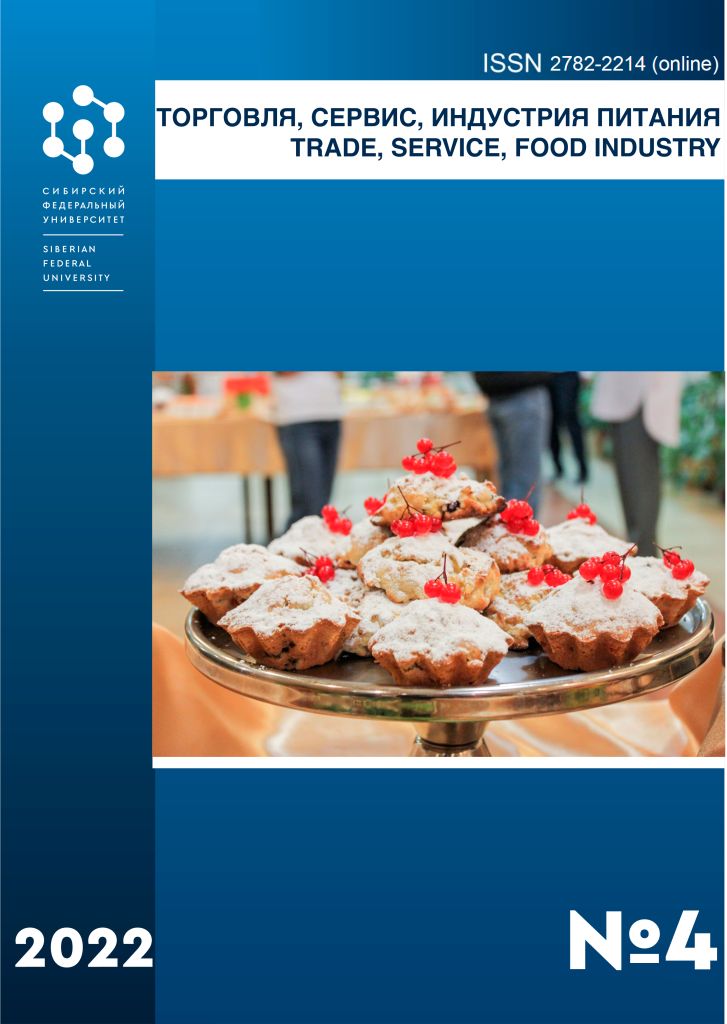Krasnoyarsk, Russian Federation
Krasnoyarsk, Russian Federation
Krasnoyarsk, Russian Federation
from 01.01.1993 to 01.01.2021
Krasnoyarsk, Russian Federation
The issues of healthy nutrition are becoming more relevant in the XXI century, and at the government level, the Presidential program "Health of the Nation", the concept of rational nutrition, which contributes to maintaining and improving the physical and intellectual health of citizens, and improving their quality of life. One of the resources in the manufacture of therapeutic and preventive nutrition products is the use of non-traditional raw materials. The authors of the article show the possibility of using kombucha for the preparation of functional drinks, which, due to the presence of physiologically active components, in addition to basic nutrition, provide health benefits. An experimental study of organoleptic and physico-chemical quality indicators of the culture fluid of the fungus Medusomyces (Medusomyces gisevii Lindau) was carried out. During the cultivation of kombucha, the dynamics of a decrease in sucrose content and a gradual accumulation of acetic acid were revealed. The period of preparation of the drink was determined and the optimal ratio of acidity and sugar content in taste was revealed.
kombucha, culture liquid, tea infusion, kombucha tea, probiotics, acetic acid bacteria, yeast fungi
1. Nuraliev, Y. (1988). Medicinalplants. Dushanbe : Maorif, 387 p.
2. Karomatov, I. D. (2014). Tea mushroom and its use in curative practice. European Science Review. 3. 47-49.
3. Mayser, P., Fromme, S., Leitzmann, C., Gründer, K. (1995). The yeast spectrum of the ‘tea fungus Kombucha’. Mycoses. Jul-Aug., 38(7-8). 289-295.
4. Teoh, A. L., Heard, G., Cox, J. (2004). Yeast ecology of Kombucha fermentation. International Journal of Food Microbiology. Sep 1, 95(2). 119-126.
5. Greenwalt, C. J., Steinkraus, K. H., Ledford, R. A. (2000). Kombucha, the fermented tea: microbiology, composition, and claimed health effects. Journal of Food Protection. Jul., 63(7). 976-981.
6. Kozyrovska, N. O., Reva1, O. M., Goginyan, V. B., de Vera, J.-P. (2012). Kombucha microbiome as a probiotic: a view from the perspective of post-genomics and synthetic ecology. Biopolymers and Cell. 28(2). 103-113.
7. Goretskaya, T. I., Pantyukhin, D. V., Polekhina N. N. (2021). Dynamics of accumulation of biologically active substances in the culture liquid Medusomyces gisev. Sciences of Europe. 62-2. 3-6.
8. Aliyeva E. V., Boltacheva, K. M., Timchenko, L. D., Bondareva, N. I., Dobrynya, Yu. M. (2018). Antibacterial potential and prospects for the use of kombucha. Ulyanovsk Medical and Biological Journal. 4. 166-171.
9. Konovalov, I. N., Semenova, M. N. (1955). To the physiology of the Kombucha. Botanical Journal. 40. 567-570.
10. Hauser, S. P. (1990). Dr. Sklenar’s kombucha mushroom infusion - a biological cancer therapy. Documentation No. 18. Schweiz Rundsch Med. Prax. 79. 243-246.
11. Bauer-Petrovska, B., Petrushevskaya-Tozi, L. (2000). The content of minerals and water-soluble vitamins in the kombucha drink. International Journal of Food Science and Technology. 35. 201-205.
12. Danielyan L. T. (2005). Kombucha and its biological features. M.: Medicine, 176.
13. Velichansky, A. S., Tsvetkovich, D. D., Markov, S. L. (2013). Features of fermentation of kombucha on medicinal herbs of the Lamiaceae family. Romanian biotechnological letters. 18. 8034-8042.
14. Vitas, J. S., Malbasa, R. V., Grakhovac, J. A., Lonchar, E. S. (2013). Antioxidant activity of fermented milk products of kombucha with stinging nettle and winter savory. Quarterly journal "Chemical Industry and Chemical Engineering". 19. 129-139.
15. Zainullin R. A., Kunakova R. V., Gadeleva H. K., Danilova O. A., Nikitina A. A. (2010). The influence of the growing conditions of kombucha on its functional properties in preventive food drinks. News of higher educational institutions. Food technology. 4. 29-31.
16. Fedorova, R. A., Golovinskaya, O. V. (2011). Bread of functional purpose with the addition of kombucha in fusion. Bakery of Russia. 6. 22-23.
17. Zintsova, Yu. S., Shkolnikova, M. N. (2015). Development of the concept of a drink based on polycultures of rice and kombucha. Beerand beverages. 3. 22-25.
18. Sadygova, M. K., Suraeva, A. V., Zemskova, A. A. (2016). Development of recipes and technologies of bread products, enriched with eggs hellpowder and kombucha in fusion. Agricultural Scientific Journal. 11. 46-51.
19. Zakopaiko, B. A., Ilchyshina N. V., Surukhanova, I. V. (2016). Development of technological solutions for the manufacture of a drink based on culture liquid Medusomyces gisevii Lindau. Scientific Works of Kuban State Technological University. 14. 289-298.
20. Ryndin,A. A., Shanenko,E. F., Mukhamedzhanova, T. G., Grishin, A. G., Veselkov, K. A. & Konstantinova, A. S. (2019). The use of microbial cultures in the technology of functional beverages. Health, Food & Biotechnology. 1(3). 118-131. DOI:https://doi.org/10.36107/hfb.2019.i3.s268.
21. Kakhhorova, S. I. (2018). Medicinal properties of kombucha. Biology and Integrative Medicine. 1. 381-394.
22. Sotnikov, V. A., Marchenko, V. V. (2014). The Tea Mushroom drink and its technological features. Food Industry. 12. 49-52.
23. Bondareva, N. I., Mitina, S. S., Avanesyan, S. S., Timchenko, L. D. (2016). The content of ascorbic acid and rutin in the enzymatic fluid of the tea mushroom (Medusomyces gysevii) under various cultivation conditions. Science. Innovation. Technologies. 2. 147-158.
24. Gareev, V. F., Kunakova, R. V., Khalikov, R. M. (2015). Development of original functional beverages by enzymatic fermentation of glucose-fructose syrup with kombucha. Nauka-Rastudent.ru. 5 (17). 44.
25. Yashin, Ya. I. (2010). Tea: the chemical composition of tea and its effect on human health. M.: TransLit, 160 p.








